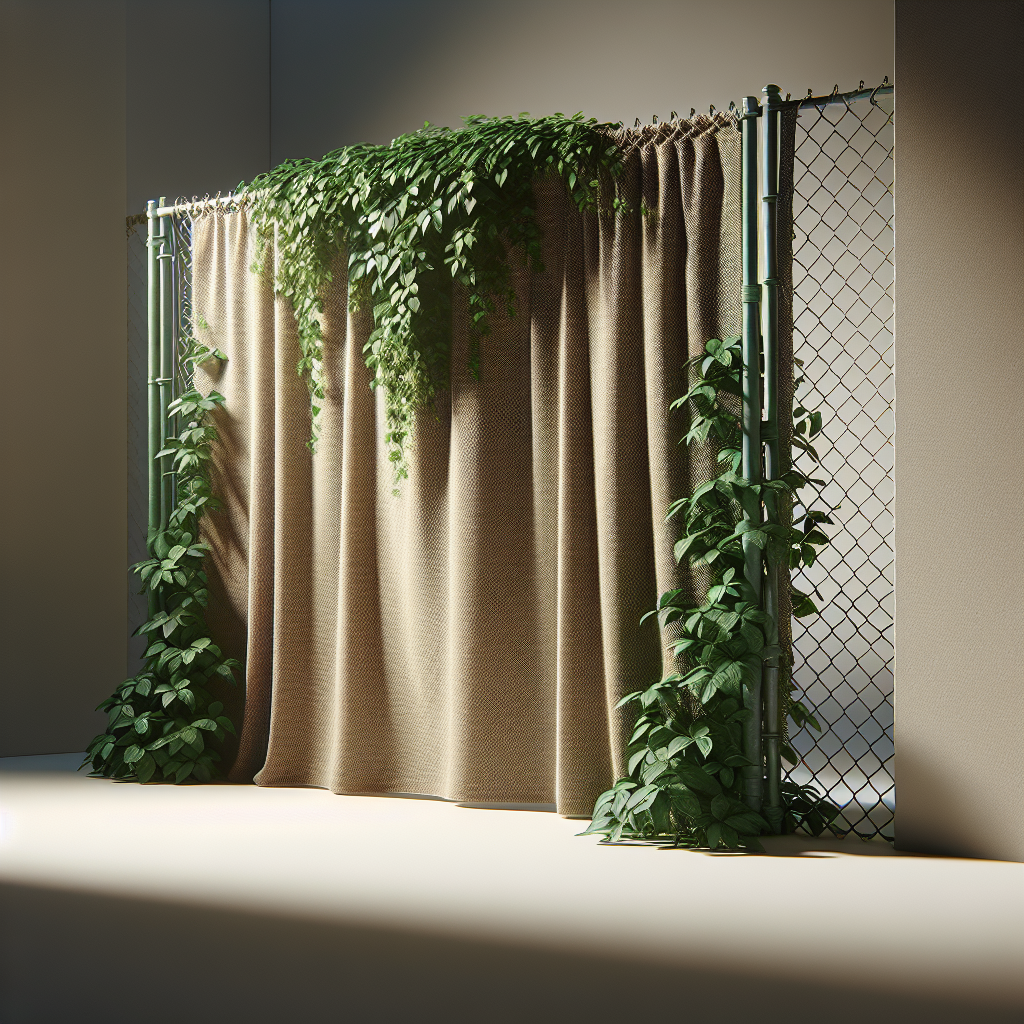Are you tired of your chain link fence feeling exposed and lacking privacy? If so, we have the perfect solution for you. In this article, we will show you exactly how to cover a chain link fence and transform your outdoor space into a secluded oasis. From simple methods like using privacy slats or bamboo screens, to more creative options like vine-covered trellises or hanging planters, we have got you covered. Get ready to say goodbye to prying eyes and hello to a private and tranquil backyard retreat.

Choosing the Right Materials
Privacy Slats
When it comes to covering a chain link fence for privacy, one popular option is privacy slats. These slats are made of various materials such as PVC, aluminum, or wood, and they are designed to be inserted into the chain link mesh. Privacy slats not only offer privacy but also add a pop of color to your fence. They come in a wide range of colors, giving you the flexibility to choose a shade that complements your outdoor space.
Bamboo Panels
If you’re looking for a natural and eco-friendly option for covering your chain link fence, bamboo panels are an excellent choice. Bamboo is a durable and sustainable material that can withstand different weather conditions. These panels can be attached directly to the fence, providing you with privacy and a unique, tropical aesthetic.
Artificial Hedge Panels
For a low-maintenance option that still offers a lush and green look, artificial hedge panels are worth considering. These panels are made of high-quality synthetic materials that mimic the appearance of real hedges. They are easy to install and require minimal upkeep, making them an attractive option for those who want privacy without the hassle of maintenance.
Vinyl Rolls
Vinyl rolls are another popular choice for covering chain link fences. These rolls are made of durable vinyl material and are specifically designed to provide privacy. They can be easily attached to the fence, creating a solid barrier that blocks the view from the outside. Vinyl rolls come in a variety of heights and colors, allowing you to customize the look of your fence while maintaining your desired level of privacy.
Climbing Plants
If you prefer a more natural and organic approach, growing climbing plants on your chain link fence can provide privacy while adding a touch of greenery to your outdoor space. Popular climbing plants for privacy include ivy, clematis, and honeysuckle. These plants can be trained to grow vertically along the fence, creating a living privacy screen. However, keep in mind that growing climbing plants may require regular maintenance and pruning to keep them in check.
Preparing the Fence
Inspecting the Fence
Before you begin covering your chain link fence for privacy, it’s important to inspect the fence for any damages or weaknesses. Check for loose or damaged sections, bent posts, or rusted areas. Repairing these issues before adding privacy coverings will ensure the longevity and stability of your fence.
Cleaning the Fence
To ensure proper adhesion and a clean surface for attaching privacy coverings, it’s essential to clean your chain link fence thoroughly. Start by using a hose or pressure washer to remove any loose dirt or debris. For stubborn stains or grime, scrub the fence with a mixture of mild soap and water using a brush or sponge. Rinse the fence thoroughly and allow it to dry completely before moving on to the next steps.
Repairing any Damages
If you discovered any damages during the inspection phase, it’s crucial to repair them before installing privacy coverings. Replace any broken or missing sections of the chain link mesh, straighten bent posts, and remove any rust by scrubbing with a wire brush. Applying a rust-inhibiting primer and paint can help prevent future rusting. By addressing these repairs, you’ll ensure a solid foundation for attaching privacy coverings.
Installing Privacy Slats
Measuring the Fence
To install privacy slats efficiently, start by measuring the length of your chain link fence. Use a tape measure to determine the total length you need to cover. This measurement will help you determine the number of privacy slats required for your project.
Choosing the Right Slats
Consider the material, color, and design when choosing privacy slats for your chain link fence. PVC slats are popular for their durability and affordability, while aluminum slats offer a sleek and modern look. Wood slats provide a natural and rustic feel to your fence. Pick a style that matches your personal taste and complements your outdoor space.
Attaching the Slats to the Fence
Attaching the privacy slats to your chain link fence is a straightforward process. Start by sliding the slats vertically into the mesh of the fence, ensuring a tight fit. Some privacy slats may require additional clips or fasteners to secure them in place. Follow the manufacturer’s instructions for proper installation. Make sure to evenly space the slats along the fence to create a uniform and visually appealing privacy barrier.
Using Bamboo Panels
Measuring and Cutting the Panels
Before installing bamboo panels, measure the length of your chain link fence to determine the number of panels needed. Bamboo panels typically come in standard sizes, but custom-cutting may be required to fit your specific fence. Use a saw or a proper cutting tool to trim the panels to the desired length.
Attaching the Panels to the Fence
To attach the bamboo panels to your chain link fence, start by securing them using zip ties or wire at the top, middle, and bottom of the panels. Ensure that the panels are straight and properly aligned. The zip ties or wire should be tightly fastened to prevent any movement or sagging. Trim off any excess zip tie or wire for a clean and finished look.

Installing Artificial Hedge Panels
Measuring and Cutting the Panels
Measure the length of your chain link fence to determine how many artificial hedge panels you need. Artificial hedge panels usually come in standardized sizes but may require trimming to fit your fence. Carefully cut the panels to the appropriate size, ensuring straight lines and smooth edges.
Attaching the Panels to the Fence
To attach the artificial hedge panels to your chain link fence, use zip ties or wire to fasten them securely. Start at the top of the fence and work your way down, securing the panels at regular intervals. Make sure the panels are aligned properly and sit snugly against the fence. Trim any excess zip ties or wire for a clean appearance.
Covering the Fence with Vinyl Rolls
Measuring the Fence
To cover your chain link fence with vinyl rolls, start by measuring the length of the fence. This measurement will help you determine the number and size of vinyl rolls needed. Ensure accurate measurements to avoid any shortage or excess.
Preparing the Fence
Clean the chain link fence as mentioned earlier in this article to ensure a smooth and clean surface for the vinyl rolls. Additionally, inspect the fence for any damages and make any necessary repairs before proceeding.
Attaching the Vinyl Rolls to the Fence
Start at one end of the fence and unroll the vinyl along the length. Ensure the vinyl is aligned with the top and bottom of the fence. Use zip ties or wire to secure the vinyl rolls to the chain link mesh. Secure the vinyl at regular intervals to prevent sagging or movement. Trim off any excess vinyl to create a neat and tidy look.

Growing Climbing Plants for Privacy
Choosing the Right Plants
Selecting the right climbing plants is crucial for achieving an effective privacy screen. Consider factors such as the climate in your area, the amount of sunlight the fence receives, and the growth habits of the plants you choose. Ivy, clematis, and honeysuckle are popular choices due to their ability to grow quickly and provide dense coverage.
Preparing the Fence
Before planting climbing plants, ensure that your chain link fence is in good condition. Repair any damages and clean the fence thoroughly to create an ideal environment for plant growth. Consider adding a trellis or supports to help guide the plants as they grow.
Planting and Supporting the Climbing Plants
Dig holes at the base of the fenceposts and plant the climbing plants according to their specific planting instructions. Train the plants to grow vertically along the fence by gently attaching them to the chain link mesh using plant ties or soft fabric strips. As the plants grow, continue to provide support and regularly prune them to maintain a clean and tidy appearance.
Adding Additional Privacy Features
Outdoor Curtains
If you’re looking to add a touch of elegance to your privacy solution, outdoor curtains are a fantastic option. Install a curtain rod at the top of your chain link fence and hang weather-resistant curtains in colors and patterns that suit your taste. Outdoor curtains not only provide privacy but also create a cozy and intimate ambiance in your outdoor space.
Decorative Screens
Decorative screens are a versatile privacy solution that adds a decorative element to your chain link fence. These screens come in various materials such as metal, wood, or composite and feature intricate patterns or designs. Install the screens in front of the chain link fence, allowing gaps or overlapping for privacy and aesthetic appeal.
Freestanding Privacy Panels
Freestanding privacy panels offer flexibility in terms of placement and design. These panels can be positioned strategically around your outdoor space to create privacy zones. Choose from a variety of materials such as wood, metal, or composite, and select designs that complement your existing decor. Freestanding privacy panels are also portable, allowing you to rearrange them as needed.

Maintaining Privacy Coverings
Regular Cleaning and Maintenance
To ensure the longevity and effectiveness of your privacy coverings, it’s important to establish a regular cleaning and maintenance routine. Each type of covering may require specific care, so follow the manufacturer’s instructions. Generally, regular cleaning with mild soap and water, and periodic inspections for damages or wear, will help keep your privacy coverings in excellent condition.
Monitoring and Repairing Damages
Keep an eye out for any damages or wear on your privacy coverings, especially after severe weather or heavy use. Repair any loose slats, damaged panels, or torn vinyl rolls promptly to maintain the privacy and aesthetic of your fence. Consider having extra materials on hand to replace any damaged components quickly.
Evaluating Local Regulations
Checking Fence Height Restrictions
Before adding privacy coverings to your chain link fence, it’s crucial to check local regulations regarding fence height restrictions. Ensure that your chosen privacy solution complies with these regulations to avoid any legal issues or requests to remove the coverings.
Obtaining Permits if Required
In some areas, permits may be necessary to cover your chain link fence for privacy, especially if the chosen method significantly alters the appearance or height of the fence. Check with your local municipality or homeowners’ association to determine if permits are required. Obtaining the necessary permits will ensure that you can enjoy your covered fence without any legal complications.
Covering a chain link fence for privacy allows you to create a secluded and intimate outdoor space while enhancing the aesthetic appeal of your property. Whether you choose privacy slats, bamboo panels, artificial hedge panels, vinyl rolls, or opt for climbing plants, there are options to suit every preference and budget. By following the step-by-step guidelines outlined in this article and adhering to any local regulations, you’ll be well on your way to transforming your chain link fence into a private oasis that reflects your unique style and provides peace and tranquility in your outdoor living area.

